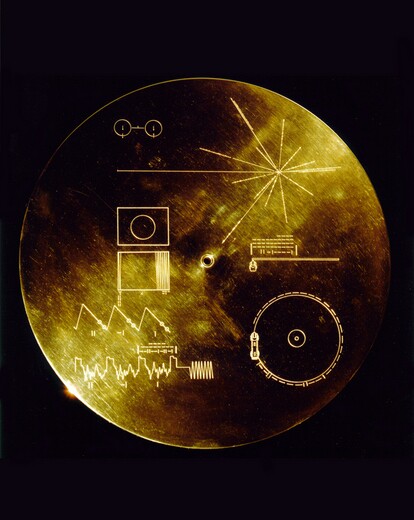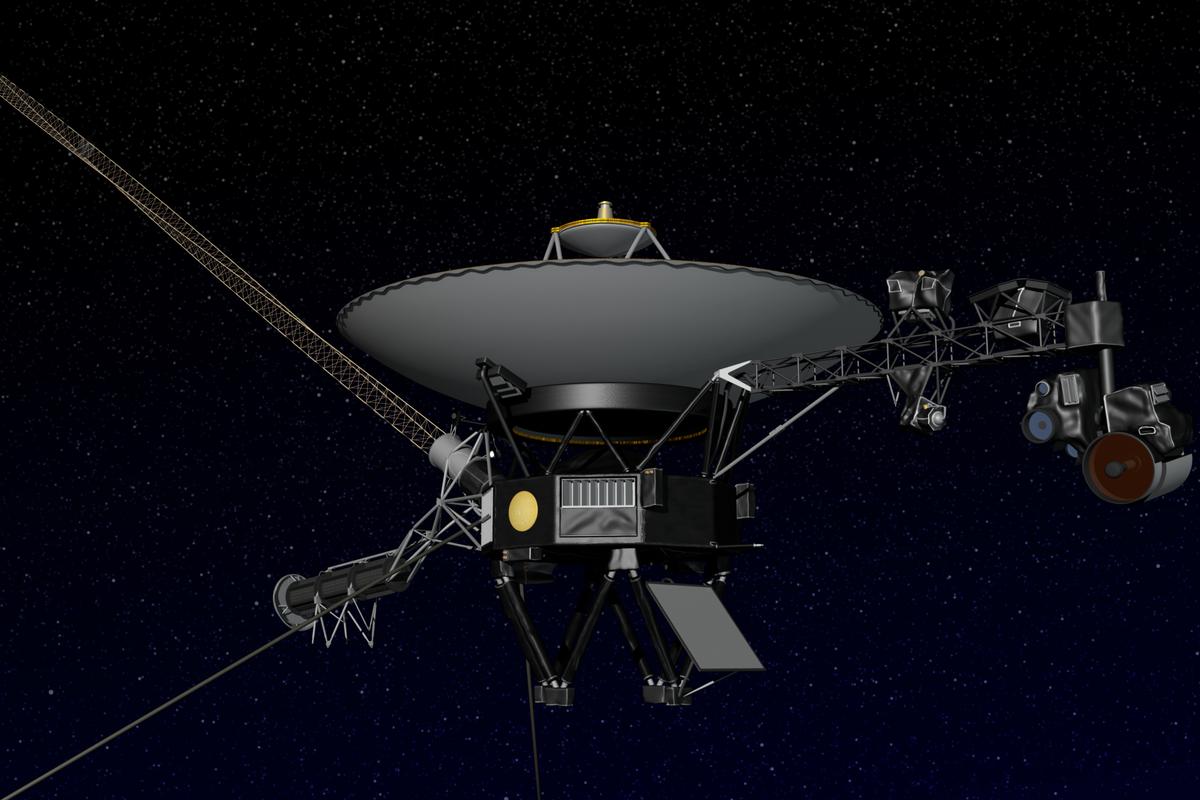The last time we checked on the Voyager 1 & 2 they were hurtling towards the edge of the solar system at over 37,000 mph (60,000 km/h). The car-sized spacecraft are now and incredible 11 billion miles (17 billion km) and 8 billion miles (14 billion km) from Earth respectively - they are the longest continuously operated spacecraft in deep space and, having traveled further than any man-made object, they will soon become the first to enter the realm of interstellar space. NASA recently held a briefing on the achievements of the program which gives us the opportunity to ponder where the Voyagers are, where they are going and the amazing scientific discoveries realized so far in their 33 year journey.
Built by NASA's Jet Propulsion Laboratory in Pasadena, California, Voyager 2 was launched on Aug 20, 1977, closely followed by Voyager 1 on Sept 5. It was a special year because there was a rare planetary alignment of the outer planets, which meant the spacecraft would be able to visit all four giant gas planets; Jupiter, Saturn, Uranus and Neptune.
Flybys of Jupiter, Saturn, Uranus and Neptune
The Voyager twins' primary five year mission was to explore Jupiter (which was reached in 1979) and Saturn (1980). The spacecraft captured images of the planets, their larger moons and Saturn's rings, making some amazing discoveries. Jupiter's Red Spot was found to be a massive hurricane three times the diameter of Earth and just one of many huge storms on the planet. Saturn's rings were revealed to be made of a mish mash of icy particles - some as large as a house. Io, one of Jupiter's moons, was observed to have eight active volcanoes, where previously volcanic eruptions were only known on Earth.Voyager 2, propelled further by Jupiter and Saturn's gravity, continued to Uranus in 1986 and Neptune in 1989. Breathtakingly close up pictures were taken of the planets, their moons and the system of rings and magnetic fields surrounding each. Notable discoveries included the fact that Uranus spins on a horizontal axis. Neptune the most remote giant planet has the fastest winds in the solar system that travel at over 1,200 mph (2,000 kph). Like Jupiter, it has a Great Dark Spot of its own, a giant storm about the size of Earth. Triton, a moon of Neptune is the coldest measured object in the Solar System. It has a surface temperature of -390°F (-235°C) with geysers spewing nitrogen gas into the atmosphere.
The Voyager spacecraft rewrote the textbooks on the four gas giants revealing the complexity and diversity of our solar system. On its way out of our solar system, Voyager 1 was asked to look back and take more photograph before the cameras were turned off. The "Pale Blue Dot" photograph was taken from a record distance of more than four billion miles from Earth and is part of the resulting is 60 frame mosaic of the solar system. In the photo, the Earth appears as a tiny dot 0.12 pixels in size, giving us a mind-boggling reminder of just how small we are in the vastness of space.

Still making discoveries and performing tricks
Voyager 1 will soon be the first probe to go outside our solar system. Using the gravitational force of Saturn and Jupiter, it swung North of the planetary plane and onwards to interstellar space. It is now over 117 times further from the Sun than we are and at this distance, the Sun is very dim - 1/10,000 as bright as it is here on Earth. Voyager 2 is traveling at a slower speed, it is approximately 3 billion kilometers closer to us than Voyager 1 and heading south of the planetary plane.
The spacecraft is an incredible workhorse performing new tricks and old ones after long periods of time have passed. Voyager 1 was recently asked to perform a scan using its low energy charge particle instrument. This required a maneuver not performed since the Pale Blue Dot photograph was taken in 1990. The spacecraft was asked to rotate 70 degrees to scan data in three dimensions, hold for three to five hours and then swing back around to celestial lock.
Voyager 1 is currently in a type of "deadzone" called the heliosheath, a region where the solar wind is made turbulent by its interaction with the interstellar medium. The purpose of this scan, which will be repeated every three months, is to use the spacecraft's low energy charge particle instrument to determine when it passes beyond the very edge of our Sun's influence. Scientists believe that there are only a few more years of travel left before Voyager breaks free and can truly be called a traveler amongst the stars.
The signals traveling at the speed of light now take 13 hours one way to reach Earth from Voyager 2, and 16 hours one way from Voyager 1. To help put the distance into perspective; typical signals from Mars missions take 10 minutes one way. The signals are now so faint that they require the largest antennas on Earth to track them.
Equipment onboard Voyager
The Voyager spacecraft are identical. The size and weight of a small car, they are made up of a 10 sided main structure called the bus, a high-gain antenna, three booms that hold scientific instruments, the power supply and two other antennae. The main antenna is 12 feet (3.7 meters) across and looks like a satellite dish. This antenna is how the Voyagers receive commands from Earth and send data they gather back. No matter where a Voyager spacecraft is in space, the high gain antenna always points towards the Earth.The spacecraft are powered by a radioisotope thermoelectric generator, in essence a nuclear battery. Pellets of plutonium release heat through natural decay and are converted into electricity using a series of thermocouples. It is a safe, reliable and long lasting power source expected to be finally depleted somewhere around 2025. Voyager's thrusters are fueled by hydrazine and there is enough on board to last another 60 years as fuel is only used to reorient the spacecraft. It uses about 1.6 grams per day.
Voyager carries various scientific instruments along with three computers that share just 68 KB of memory. Engineers developed a self repairing, programmable command processor with multiple modules that are able to determine errors by comparing past data.
The "Sounds of Earth"
The spacecraft are famous for carrying identical golden phonograph recordings titled the "Sounds of Earth." The records contain a cultural time capsule, images, natural sounds, spoken greetings in over 50 languages and musical selections from different cultures and eras. The gold plated copper records are 12 inches (30 cm) across and contain sounds and images selected to illustrate the diversity of life and culture on Earth. A gold plated aluminum cover etched with scientific hieroglyphics was designed to protect the records from micrometeorite bombardment. The cover shows an explanatory diagram on how to play the recordings and displays our cosmic address, illustrating the 16 closest pulsars along with an atomic clock explaining Voyager's launch date. The diagram appears on both the inner and outer surfaces of the cover because the outer diagram will be eroded in time.

The records should not to be confused with the simpler metal plaques on Pioneers 10 and 11 which were launched in 1972. The plaques were designed to show scientifically minded extraterrestrials when Pioneer was launched, from where and by whom. They present amongst other things, a male raising his right hand in a gesture of goodwill.

A "Noah's Ark of human culture"
The golden records were a much more ambitious message than the Pioneer plaques, created as a "Noah's Ark of human culture". Over 100 pictures illustrating Earth were collated, each like a tile in a large mosaic of life on Earth. They present people doing mundane activities such as eating and drinking as well as showing our anatomy and DNA structures. Plants and animals are included along with scenes from around the world such as a Thai craftsman, a gymnast and a schoolroom. Various landmarks including the Golden Gate Bridge, the Sydney Opera House, the Great Wall of China, the Taj Mahal and UN buildings are also documented.Over 90 minutes of recordings are included ranging from storms and volcanoes to human made sounds like a mother kissing her child and rocket takeoffs. Greetings in over 50 different languages and 27 pieces of music including Beethoven, Bach, Mozart, world music from China, Japan, India and Peru. There's also a rock'n'roll track - "Johnny B Good" by Chuck Berry (not the Rolling Stones as falsely shown in the movie Starman).
The future of Voyager
Once outside the heliosphere, Voyager 1 will take measurements of the vast clouds that envelope our solar system. These clouds are remnants of stars that exploded five to ten million years ago. NASA hopes to operate Voyager until 2025 when it will then be left to wander throughout the galaxy for another 1000 million years.The spacecraft are still functioning and thriving after more than 30 years. Robust, durable and built from 1970s components, the transistors are still functioning today. They have exceeded their design specifications and the loftiest dreams of their makers ... and despite having already made an amazing contribution to our civilization, many great discoveries are still to come.
Voyager 1 is on a trajectory to reach star AC+79 in about 40000 years. Voyager 2 is on its way to the vicinity of star Sirius, a mere 296,000 years away.
You can keep up to date with how far the Voyagers are from home with NASA's real-time odometer.
































